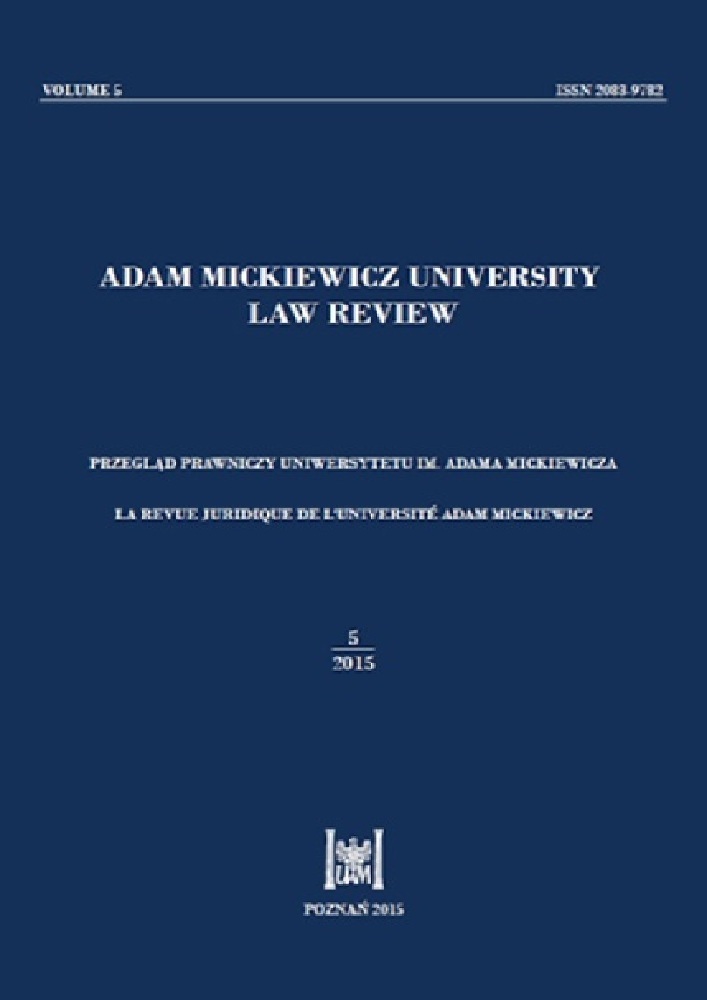Abstract
The article presents the political and legal changes that accompanied the passing and then the introduction of the Ostmarkgesetz in Austria in 1939. It also contains a detailed analysis of the structure and layout of this normative act. The Ostmarkgesetz was extremely important because it thoroughly changed the administrative organization and introduced a new administration of the state in this area. The consequences had a significant impact on the Austrian legal order. This law is considered to be one of the main tools of the direct annexation of Austria by the Third Reich. This was the beginning of the subsequent war conquests of the Nazi state.
References
Batowski H., Rok 1938: dwie agresje hitlerowskie, Poznań 1985.
Czerwińska-Schupp E., Faszyzm austriacki (1934–1938) – założenia filozoficzno-ideowe, ustrojowe i praktyka polityczna, „Filozofia Publiczna i Edukacja Demokratyczna”, 2021, I, no. 2.
Foster N., Austrian Legal System and Laws, London 2003.
Gumkowski J., Kułakowski T., Zbrodniarze hitlerowscy przed Najwyższym Trybunałem Narodowym, Warszawa 1965.
Goschler C., The Dispossession of the Jews and the Europeanization of the Holocaust, in Business in the Age of Extremes. Essays on Modern German and Austrian Economic History, ed. D. Ziegler, Washington 2013.
Grünberg K., Adolf Hitler. Biografia Führera, Warszawa 1988.
Jedlicka L., Bundesprasident Wilhelm Miklas am 13 Marz 1938, „Mitteilungen des Instituts für Österreichische Geschichtsforschung”, 1963, LXXX.
Jung O., Plebiszit und Diktatur: die Volksabstimmungen der Nationalsozialisten, Tübingen 1995.
Kaźmierczak P., Morderca robotników czy bohaterski kanclerz? Austriackie spory o Engelberta Dollfussa, in ed. A. P. Bieś, Pamięć. Historia. Polityka, Kraków 2012.
Kozeński J., Zabór Austrii w 1938 r. i przezwyciężenie idei Anschlussu po II wojnie światowej, „Przegląd Zachodni” 1968, no. 3.
Luterpacht H., Annual digest and reports of public international law cases. Being a Selection from the Decisions of International and National Courts and Tribunals given during the. Years 1941–1942, Cambridge 1987.
Pawłowski S.., Kwestia tożsamości państwa przykładzie Austrii, „Gdańskie Studia Prawnicze”, 2014, XXXI.
Rathkolb O., The Neglected Factors Leading to the “Anschluss” 1938, “Wien Klin Wochenschr” 2018 no. 130.
Rosenkötter B., Treuhandpolitik, Die „Haupttreuhandstelle Ost” und der Raub polnischer Vermögen 1939–1945, Essen 2003.
Rudawski B., Mienie i rasa. Wybrane aspekty „aryzacji” majątku żydowskiego w trzeciej rzeszy i w Kraju Warty, „Meritum”, 2016, VIII.
Rüthers B., Die Unbegrenzte Auslegung, in Nationalsozialismus und Recht. Rechtssetzung und Rechtswissenschaft in Österreich unter der Herrschaft des Nationalsozialismus, ed. U. Davy, Wien 1990.
Stickler W., Führungsstruktur und inszenierte Befehlsausgabe im Nationalsozialismus. Die Politischen Leiter der NSDAP im Reichsgau Wien und die Dienstappelle Baldur von Schirachs, Wien 2012.
Tomaszewski J., Żydzi w II Rzeczpospolitej, Warszawa 2016.
Waldenegg Ch. G., Hitler, Göring, Mussolini und der „Anschluß” Österreichs an das Deutsche Reich, “Vierteljahrshefte fur Zeitgeschichtes” 2003, 2.
Walterskirchen G., Engelbert Dollfuss. Arbeitermörder oder Heldenkanzler, Wien 2004.
Wereszycki H., Historia Austrii, Wrocław 1986.
Verbindung mit dem Reichsstatthaltergesetz, RGBl I, 1935/23.
Deutsche Gemeindeordnung vom 30. Januar 1935, RGBl I, 1935/55.
Verordnung über die Anmeldung des Vermögens von Juden war eine Verordnung, RGBl, I, 1938/35.
Verordnung über das Gesetzgebungsrecht im Lande Österreich, RGBl I., 1938/43.
Bestellung des Reichskommissars für die Wiedervereinigung Österreichs mit dem Deutschen Reich, RGBl I, 1938/65.
Bundesverfassungsgesetz über die Wiedervereinigung Ósterreich mit dem Deutschen Reich, BGBl I, 1938/75.
Bundesverfassungsgesetz über die Wiedervereinigung Ósterreich mit dem Deutschen Reich, RGB l, 1938/237.
Gesetz über den Aufbau der Verwaltung in der Ostmark, RGBl I 1939/77.
Statistischen Reichsamt, Amtliches Gemeindeverzeichnis für das Deutsche Reich, Teil I: Altreich und Land Österreich, Vierte Auflage, Berlin 1939.
